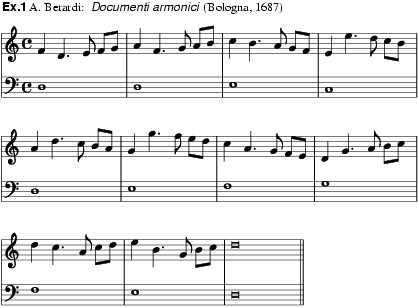
(It.).
A term used mainly during the 17th and 18th centuries to designate the persistent repetition of a figure or motif. Its use as a technical term in music would have been suggested by a meaning that was current in the 17th and 18th centuries but is now obsolete: ‘obstinacy’ or ‘persistence’. Berardi, in his Documenti armonici (1687, pp.17–20), defined the perfidia as the continuation of a figure according to one's whim (‘continuare un passo à capriccio’). His eight music examples clarify his meaning: against a cantus firmus a second voice (higher or lower) develops a contrapuntal line in which the same rhythmic figure is repeated in each bar except the last. Berardi's first example, headed ‘Della semiminima col punto sincopata, e perfidiata con trè Crome’, is given in ex.1. Brossard, who knew Berardi's treatise, offered a similar but broader definition in his Dictionaire (1701): ‘an affectation to do always the same thing, to follow always the same pattern’. Brossard's understanding of the term includes the ‘fuga perfidiata’ as well as ostinato basses. His wider definition permitted him to equate the perfidia with Zarlino's ‘pertinacia’ (Le istitutioni harmoniche, 1558, iii): in Zarlino's examples it is the melodic pattern of the counterpoint to a cantus firmus that remains constant, while the note lengths are changed – the opposite of Berardi's examples, in which rhythm is the constant factor and pitches change. Walther (Musikalisches Lexicon, 1732) and Rousseau (Dictionnaire de musique, 1768) both followed Brossard's definition closely. Three short passages of music attributed to Torelli (in manuscripts in I-Bsp) are given the label ‘perfidia’ (nos.65–7 in Giegling's catalogue, 1949); the first may be spurious, and the second and third are part of the same work. They are 29, 28 and 13 bars in length, are scored for two violins and bass, and feature brilliant figuration for the violins over a sustained bass pedal. It is reasonable to assume that they originally formed part of longer works. A similar passage, but without the heading ‘perfidia’, occurs at the end of the second movement of Corelli's sonata op.5 no.3 (see Cadenza, ex.6). There is a loose connection between Berardi's and Torelli's terminology: in both cases passages of figuration are heard either against a slow-moving cantus firmus or above a static bass. The perfidia is discussed by P. Whitmore in Unpremeditated Art: the Cadenza in the Classical Keyboard Concerto (Oxford, 1991), 38–41.

ANDREW V. JONES